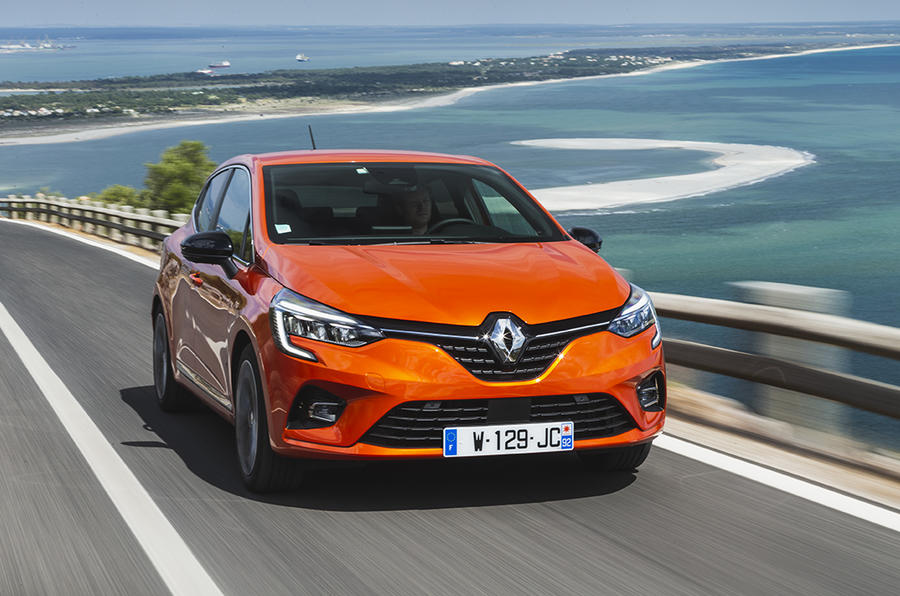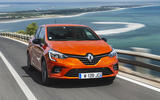What is it?
Disregard the familiar visual cues: the fifth-generation Renault Clio is very much new, right down to its unseen – and never-before-seen – platform.
Every panel is new, and even though the window apertures are identical to the old Renault Clio, the windows themselves are new, too. The body-in-white is new and 22kg lighter than before; the subframes are most definitely new; the suspension is similar to before but very much new; and the engines are largely new. Headrests, gearstick, steering wheel? New.
This all-round newness is in contrast to the Clio’s in-house status as ‘grandmother’ car, as chief engineer Gilles Mulato puts it. That means it pioneers entire substems for the Renault and will donate them to other models, not least in the form of that modular CMF-B platform.
We’ll come back to that in a moment, but rarely is it far from the limelight. The latest incarnation of Europe’s best-selling small car (Volkswagen Polo second, Ford Fiesta third, though it’s a different story outside Europe) is physically smaller than before but more capacious – useful developments both. We’re told it is also ready for hybrid powertrains, hosts a class-leading array of driver-assistance systems, and we can surmise Renault’s primary aim is to finally plant the Clio into the vacant but narrow fissure between the Fiesta’s dynamic abilities and the refinement of the Polo, which would make it the Goldilocks supermini. All of this is intrinsically linked to the new platform, though Renault, by its own admission has also had ground to make up from the fourth-generation Clio in terms of both performance and interior finish, which aren’t so chassis-depedendent. It seems there’s plenty to talk about.
Unusually for Renault, exterior design isn’t such a big topic of conversation. It says the Clio is now sold mainly on its good looks, and as the previous car surpassed annual sales volumes every successive year since arriving in 2014, there’s been little appetite for design director Laurens van den Acker to shake things up. Because the Dutchman styled also the previous car – his very first Renault, since which he’s gone on to redefine the brand identity – peronsally he has very little to prove.
Neverthess, the new Clio has a larger grille than before (what, we're left wondering, doesn’t these days?) and the LED tusks from the Mégane. The bonnet now features a pair of pronounced contours and with a new bumper the whole demeanour is meaner, the car looking a little less surprised to be here. The windows surrounds are now chrome, while the rear is less heavy on the black plastic and achieves a neat minimalism by pressing the body panels in subtle, interesting ways rather than resorting to tacked-on trim. Sporty? Mature? A bit of both, to be honest. This particular example is painted Valencia Orange, and looks especially agreeable in the Portugese sun.
The engine line-up is relatively straightforward. The SCe 75 backstop is a naturally aspirated three-cylinder 1.0-litre petrol with 71bhp, though more popular will be the turbocharged TCe 100 version, which makes 99bhp and is the car we’re driving here. For now, the top-spec petrol is the TCe 130, which uses the same turbocharged 1.3-litre four-cylinder engine found right across Renault’s model range and benefits from direct fuel injection. It’s also the only Clio available with a seven-speed dual-clutch gearbox, and the only one capable of hitting 62mph from rest is less than 10 seconds.




































Join the debate
Add your comment
Confusing title
Automated driving...
Don't look.
Don't stop.
Don't indicate.
I think that's what they are referring too.
Looking forward to the Renault Sport version
It should be something special with this as a base.
So safe it's a risk?
Comes across as a very able car, carefully improved and matured, wrapped in a very attractive (if familiar) body. The interior looks like a quality and calming environment, airy and soothing - some might find it a little dull, perhaps.
The controversy is just how incremental is the evolution of the exterior styling. Will it remain fresh enough to maintain momentum in terms of presence and sales in the market beyond 24-30 months. The new 208 looks a much more future-proofed design, although it's not as sexy.
That said, it would be on my test-drive list along with the Fiesta, Ibiza and new 208.